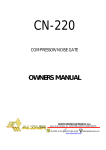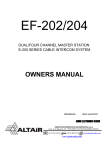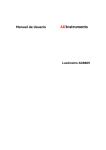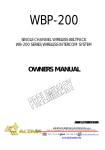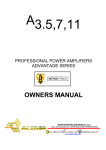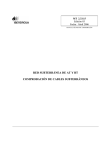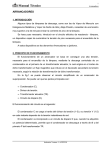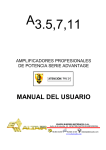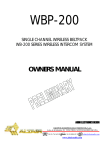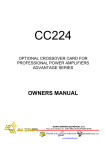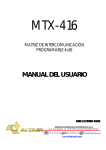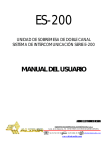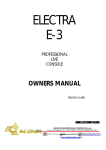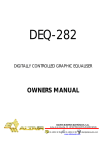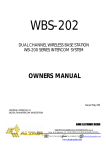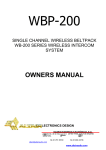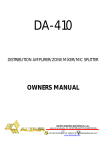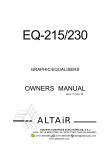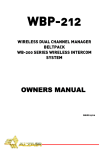Download OWNERS MANUAL - Veranstaltungstechnik mieten
Transcript
NG-440 QUAD NOISE GATE OWNERS MANUAL EQUIPOS EUROPEOS ELECTRÓNICOS, S.A.L Avda. de la Industria, 50. 28760 TRES CANTOS-MADRID (SPAIN). 34-1-804 32 65 34-1-804 43 58 [email protected] www.altairaudio.com QUAD NOISE GATE 2 1. INTRODUCTION...............................................................................................................................................................3 2. SWITCHES, CONTROLS, ADJUSTMENTS AND CONNECTORS.................................................................................4 FRONT PANEL.................................................................................................................................................................4 REAR PANEL....................................................................................................................................................................5 3. WORKING PRECAUTIONS.............................................................................................................................................6 4. INSTALLATION ................................................................................................................................................................6 UNPACKING...................................................................................................................................................................6 MOUNTING ....................................................................................................................................................................6 CHANGING THE VOLTAGE AND THE FUSE................................................................................................................6 CONNECTING TO THE MAINS .....................................................................................................................................7 INPUT CONNECTION.....................................................................................................................................................7 UNBALANCED INPUT.................................................................................................................................................8 BALANCED INPUT ......................................................................................................................................................9 OUTPUT CONNECTION.................................................................................................................................................9 UNBALANCED OUTPUT........................................................................................................................................... 10 BALANCED INPUT ..................................................................................................................................................... 11 GROUND LINK .............................................................................................................................................................. 11 5. OPERATION ................................................................................................................................................................... 12 TEST MONITOR SWITCH (SIDE TEST) ........................................................................................................................ 12 ACTIVITY LED’s (SHUT — OPEN).................................................................................................................................. 13 HP AND LP KEY FILTER CONTROLS........................................................................................................................... 13 THRESHOLD CONTROL............................................................................................................................................... 13 ATTACK TIME SWITCH................................................................................................................................................ 13 RELEASE TIME CONTROL ............................................................................................................................................ 13 RANGE SWITCH ........................................................................................................................................................... 14 BYPASS SWITCH.......................................................................................................................................................... 14 GAIN REDUCTION VUMETER ..................................................................................................................................... 14 STEREO SWITCH .......................................................................................................................................................... 14 6. OPTIONS........................................................................................................................................................................ 14 SECURITY COVER (TP-1) .............................................................................................................................................. 14 KEY LOCKED SECURITY COVER (TS-1)....................................................................................................................... 14 7. BLOCK DIAGRAM AND HOW IT WORKS.................................................................................................................. 15 8. REPAIR GUIDE............................................................................................................................................................... 15 9. APPLICATION EXAMPLES............................................................................................................................................ 16 SUPPRESSING CROSSTALK IN MULTI-MIC APPLICATIONS .................................................................................. 16 REDUCING BACKGROUND NOISE ............................................................................................................................ 17 REDUCING FEEDBACK IN MICROPHONES WITH HIGH COMPRESSION............................................................. 17 10. TECHNICAL SPECIFICATIONS .................................................................................................................................... 18 11. WARRANTY................................................................................................................................................................... 19 QUAD NOISE GATE 3 1. INTRODUCTION Congratulations on your purchase of the ALTAIR noise gate NG-440. Our dilated experience in the design and manufacture of effect processing equipment had led to us to carry out this noise gate of great performances. There is a lot the characteristics that make of the ALTAIR NG-220, one of the most highlighted of the audio professional market, here enumerated some: The ALTAIR NG-440 incorporates in a compact unit, four identical full-featured Noise Gate sections. The device consists basically in an open-close switch activated by a user selectable Threshold level. Both open-close transition and background noises in SHUT state are optimised to guarantee a transparent click-free operation for High End Professional Audio applications. Stereo switches between Sections 1-2 and Sections 3-4 adapts the unit to Quad, Dual/Stereo or mixed program materials by tracking gate timing and Gain Reduction parameters from both channels at a time, from CH-1 panel controls only. This ensures that both gates are opened and closed simultaneously avoiding Stereo Image loss. Dedicated filters are provided to Trigger the gate, only by the desired instrument avoiding false gating. Test monitoring of the filtered signal is available to set-up the gate effect by ear. Front panel Attack and Release time parameters are included for optimal sound reconstruction or for special effects creations. Background stage noises are easily removed enhancing instrument control and mixing operation. Spatial image of the sounds becomes more noticeable. Applications include sound reinforcement, drum or vocal gating, studio mic processing and effectively, noise reduction for almost any audio signal path, by way of expanding the dynamic range. Ease of operation, compact size, and full specs converge in the Altair NG-440 to make it a new member of your effects processing rack. Naturally, you want to use your noise gate, but before beginning is important that you read this manual. This manual will help you to install and use your new noise gate. It is very important that you read it carefully, mainly the paragraphs marked as NOTE, PRECAUTION and DANGER, for your security. Save the original packing, you can re-use it to transport the unit. NEVER SHIP THE ALTAIR NG-440 WITHOUT IT'S ORIGINAL PACKING. FRONT PANEL ATTACK TIME SWITCH. GAIN REDUCTION VU-METER. STEREO/DUAL SWITCH. RANGE SWITCH. POWER SWITCH. BYPASS SWITCH. ACTIVITY LED’s. RELEASE TIME CONTROL. THRESHOLD CONTROL. HP AND LP KEY FILTER CONTROLS. TEST MONITOR SWITCH. These are the switches, controls, adjustments and connectors that you could find in your ALTAIR noise gate. The description and explanation of each one of them, you will find in the corresponding section. 2. SWITCHES, CONTROLS, ADJUSTMENTS AND CONNECTORS QUAD NOISE GATE 4 REAR PANEL INPUT SIGNAL CONNECTORS, XLR-3-31 AND JACK ¼”. OUTPUT SIGNAL CONNECTORS, XLR-3-32 AND JACK ¼”. EARTH LINK SWITCH. MAINS CONNECTOR, FUSE HOLDER AND VOLTAGE SELECTOR. QUAD NOISE GATE 5 QUAD NOISE GATE 6 3. WORKING PRECAUTIONS The manufacturer is not responsible of any damage occurred in the noise gate unit outside the limits of the warranty or those produced by not keeping in mind the working precautions. Mains voltage must be correct and the same as that setting on the rear of the unit voltage switch. Damage caused by connection to improper AC voltage is not covered by any warranty. DANGER: Inside the unit there are high voltages, doesn't open it. The unit doesn't contain elements that could be repaired by the user. Whenever the noise gate unit is connected to the mains, contains elements with high voltages. In order to disconnect the unit completely, you must disconnect it of the mains. CAUTION: Protect the noise gate from the rain and moisture. Ensure that no objects or liquids enter it. If liquid is spilled into the unit, disconnect it from the mains and consult a qualified service technician. Don't place the unit close to heat sources. 4. INSTALLATION UNPACKING Before leaving from factory, each noise gate was carefully inspected and tested. Unpack and inspect the unit for any damage that may have occurred during shipment. If any damage is found, doesn't connect the unit to the mains, notify the salesperson immediately, because a qualified service technician must inspect the unit. Save the original packing, you could use if you need to transport the unit. NEVER SHIP THE NOISE GATE WITHOUT IT'S ORIGINAL PACKING. MOUNTING It is always advisable to mount the unit in rack, either for mobile or fixed installations, for protection, safety, aesthetics, etc. The ALTAIR NG-440 is designed for standard 19" rack mounting, and occupy 1u high rack space. CHANGING THE VOLTAGE AND THE FUSE The noise gate unit is set to operate at 230V, 50-60Hz and at 115V, 50-60Hz. Make sure that the unit is disconnected of the mains. In the unit rear panel, is placed the mains connector, the mains selector and the fuse holder. The box bellow this mains connector is called fuse holder + mains selector. Take out the fuse holder + mains selector. Upon extracting the fuse holder, the fuse will appear, take out it and change for the new one. Insert the fuse holder into the mains connector again, without spin it (make sure that the voltage to which it is going to connect the unit remains indicated in normal position, not inverted), if you only wants to change the fuse. If what you want are change the mains voltage, rotate the fuseholder until remains the mains voltage to which it is going to connect the unit in normal position, not inverted. QUAD NOISE GATE Noise gate set up to 115 V. Noise gate set up to 230 V. Make sure that the fuse is the right one for the selected voltage: FUSE (230V. 50-60 Hz) T0,5A. FUSE (115V. 50-60 Hz) T1A. NOTE: The fuseholder provide a place for spare fuse. CAUTION: Always make sure upon changing the fuse, that this is the adequate for the selected mains voltage (T1A for 115V and T0,5A for 230V). CONNECTING TO THE MAINS The connection of the noise gate power supply to the mains takes place by a standard cord included in the box. Make sure that the unit power switch is at 0 position (turned off). Insert the female I.E.C. connector of the tripolar cable into the unit power supply male connector, placed at the rear panel. Insert the male connector of the tripolar cable into the mains plug. Turn on the unit power switch. In that moment the ACTIVITY LED indicator (red or green) of the noise gate section will light, indicating that the unit is turned on. CAUTION: Make sure that the mains voltage is the correct as well as their fuse is the adequate. . INPUT CONNECTION The noise gate input signals is carried out through two XLR-3-31 female connectors and two JACK ¼” wired internally in parallel mode, one per each channel. The input connections are balanced, with a nominal impedance of 10 KΩ (5 KΩ unbalanced). The next list shows the input pins correspondence as A.E.S recommendation practice: 7 8 QUAD NOISE GATE XLR-3-31 0V PIN 1 PIN 2 HOT (+) COLD (-) PIN 3 JACK ¼” TIP HOT (+) COLD (-) RING 0V SLEEVE TIP. RING. SLEEVE. The input connection depends on two factors, the first is the type of input signal balanced or unbalanced, and the second the ground configuration of the sound source (floating or groundreferenced). The next pictures shows some of the different possibilities of connection, relying on the type of input signal, balanced or unbalanced and according to the ground configuration of the equipment (floating or ground-referenced). In the next diagrams, we use the following symbols: Sound source with mains cord without ground connection. Sound source with mains cord with ground connection. Sound source with the EARTH-LINK OFF. Sound source with the EARTH LINK ON. UNBALANCED INPUT This type of connection will be used when the sound source doesn't provide balanced output. When possible, employ the connection type 1. 1) Using twin-lead shielded cable: QUAD NOISE GATE 9 2) Using single conductor shielded cable: BALANCED INPUT OUTPUT CONNECTION The noise gate output signal is carried out through four XLR-3-32 male connectors and four JACK ¼” wired internally in parallel mode, one per each channel. The outputs are balanced, with a 10 QUAD NOISE GATE nominal impedance of 100 Ω. The next list shows the input pins correspondence as A.E.S recommendation practice: XLR-3-32 0V PIN 1 PIN 2 HOT (+) COLD (-) PIN 3 JACK ¼” TIP HOT (+) COLD (-) RING 0V SLEEVE TIP. RING. SLEEVE. The output connection depends on two factors, the first is the type of input signal balanced or unbalanced, and the second the ground configuration of the sound destination unit (floating or ground-referenced). The next pictures shows some of the different possibilities of connection, relying on the type of output signal, balanced or unbalanced and according to the ground configuration of the equipment (floating or ground-referenced). In the next diagrams, we use the following symbols: Sound destination unit with mains cord without ground connection. Sound destination unit with mains cord with ground connection. Sound destination unit with the EARTH-LINK OFF. Sound destination unit with the EARTH LINK ON. UNBALANCED OUTPUT This type of connection will be used when the sound destination unit doesn't provide a balanced input. When possible, employ the connection type 1. 1) Using twin-lead shielded cable: QUAD NOISE GATE 11 2) Using single conductor shielded cable: BALANCED INPUT GROUND LINK In some installations, it might be necessary to isolate the noise gate electric ground, from the system mains earth, in order to avoid ground loops that could generate unwanted noises. For this reason, the unit provides an EARTH-LINK switch placed at the rear panel in order to lift the mains earth from the unit. QUAD NOISE GATE 12 MAINS EARTH LINKED WITH THE NOISE GATE ELECTRIC GROUND. MAINS EARTH LIFTED FROM THE NOISE GATE ELECTRIC GROUND. NOTE: For security reasons, the earth connection to the mains is linked with the unit chassis in both cases. CAUTION: Always operate the unit with the AC ground wire connected to the electrical system ground. Precautions should be taken so that the means of grounding of a piece of equipment is not defeated. For this circumstance, NEVER lift the mains earth AC ground to avoid possible accidents. For your security, NEVER use ground isolator adapters; instead it is recommended the EARTH -LINK switch. 5. OPERATION The dynamic range of an audio equipment is limited by the maximum signal level that the audio equipment can drain without audible distortion and the noise generated by this audio equipment. The noise, is generated by the audio equipment because of the current flowing the conductors, due to the random electron movements. For statistical reasons, this produces frequencies within the whole audio spectrum. This noise is called white noise. If this noise is then strongly amplified, a noise will be obtained perfectly audible. The maximum signal level of the audio equipment is limited by the levels of the internal operating voltages. If the signal exceeded the internal operating voltages, audible signal distortion is the result. In practice, this limitation is greater, since a certain reserve must be maintained to avoid distortion of the audio signal if sudden level peak occur. In technical words, we refer to this reserve as “headroom”. If we reduce the input signal level, we reduce the risk of signal distortion due to level peeks, however, at the same time, the noise floor level will be increased if we want obtain the same output signal level, since, we must amplify more. How we explained previously, the noise limits the audio equipment dynamic range. The noise gates decrease the signal gain abruptly bellow the threshold allowing increase the audio equipment dynamic range, achieving the inverse function of a compressor/limiter. The ALTAIR NG-440 incorporates a quad Noise Gate. TEST MONITOR SWITCH (SIDE TEST) The side test switch, allow monitor the output signal obtained after the key filters to set up by ear the signal that we want to open the noise gate. It is a push button, because of that upon releasing it, the noise gate will return to its normal state. This switch will be used only during the sound check since it disables the compressor and noise gate effect. STEREO: In stereo mode at the slave channel (channel 2 or 4), this switch monitor the output signal obtained after the slave channel key filters, but the noise gate trigger with the signal obtained of the master channel (channel 1 and 4) and the slave channel key filters average. QUAD NOISE GATE 13 ACTIVITY LED’s (SHUT — OPEN): The activity LED’s show the noise gate operation. The SHUT red LED indicate that the key filters signal level output, which trigger the noise gate, is bellow the threshold set up. The other OPEN green LED report that the key filters signal level output, which trigger the noise gate, is above the threshold set up. If the BYPASS switch is not depressed, when the SHUT red LED light, the noise gate will be decreasing the input signal gain, and when the OPEN green LED light, the signal will pass unchanged through the noise gate. STEREO: In stereo mode, the slave channel (channel 2 or 4) activity LED’s, won’t indicate the slave channel noise gate operation. The master channel (channel 1 or 3) activity LED’s will indicate the operation of both noise gates. HP AND LP KEY FILTER CONTROLS The lateral filters, filter the signal that will arrive to the noise gate detector, allowing to trigger the noise gate only with the desired instrument, or with the wanted bandwidth, avoiding false gating. The high pass filter (HP) can vary between 30 Hz to 4 KHz, and the low pass filter can vary between 200 Hz and 20 KHz, allowing an adjustment in all the audible band STEREO: Like starting point, it is convenient adjust both filters of both channels (master and slave) with the same settings since the control on both channels is obtained by the two signals trigger average. THRESHOLD CONTROL The threshold control allows set up the level above the signal will pass unchanged through the noise gate. If the level is bellow this threshold, the noise gate will be decreasing the input signal gain. The threshold control can vary between —50 and +20 dBu. ATTACK TIME SWITCH The noise gate attack time is defined, as the delay in the noise gate opening (allow to pass the signal unchanged) when a signal rise above the threshold level set up. With the ATTACK switch depressed, the noise gate attack time will be configured in AUTO mode. In this mode, the noise gate detector adapts the attack time to the input program content, allowing an easy and quick noise gate adjustment on the part of the user. With the ATTACK switch pressed, the noise gate attack time will be configured in FAST mode. In this mode, the attack time is very fast, saving the signal rise edge. Therefore, in this mode the noise gate adjustment is more difficult. RELEASE TIME CONTROL The noise gate hold time is defined as the delay in the noise gate closing (decreasing the input signal gain) when a signal drop the threshold level set up. The release time begins after the hold time, and ends when the gain reduction adjusted with the RANGE switch is achieved. The release time control adjust the noise gate release time between 10 msg and 2 sg, and at the same time set up a hold time according with the release time adjustment. QUAD NOISE GATE 14 RANGE SWITCH The range switch determines the amount of gain reduction produced in the program signal when the noise gate is close. With this switch depressed, the program gain reduction will be 80 dB, and with this switch pressed, the program gain reduction will be 20 dB. In most of the applications, it is preferable use the 20 dB range, that although it don't produce a total gate, and introduce less adverse effects when signals with much noise floor are processed. BYPASS SWITCH When we press this noise gate bypass switch, the noise gate will be disabled and the controls and switched won’t be operative. The activity LED’s continue working indicating our set up, but the program signal will pass unchanged through the noise gate. GAIN REDUCTION VUMETER The gain reduction produced by the input signal compression, it is indicated in this vumeter, allowing us in all moment the visualisation of the compressor action. This vumeter is composed by 8 LED’s (30, 20, 15, 12, 9, 6, 4 and 2 dB). STEREO SWITCH The stereo switch, allow us to select the channels 1 and 2 or 3 and 4 working mode. There are two stereo switched, one affect to the channels 1 and 2 and the other affect to the channels 3 and 4. With this switch depressed, the unit operation mode is DUAL, this permit us the treatment of two independent signals, adjusting each noise gate of independent mode. Upon pressing the switch, the channel 2 or the channel 4 (depend on the stereo switch pressed) will be slave of the channel 1 or the channel 3, for what the controls of the slave channel will be disabled (except for the cases specified with the STEREO note: TEST MONITOR SWITCH, ACTIVITY LED’s and HP AND LP KEY FILTER CONTROLS, explained each one in their corresponding section). NOTE: In STEREO mode the signal that arrives to the noise gate compressor detector, is an average of the two input signals. 6. OPTIONS In this section will explain the different available options for the unit. SECURITY COVER (TP-1) In some installation, it could be necessary to tamper proof the front panel controls avoiding unwanted or accidental manipulations. For this purpose, it is available as an option, a transparent plastic security cover. The installation is very easy, by means of two screws provided. KEY LOCKED SECURITY COVER (TS-1) In some installations it is necessary isolate the compressor/noise gate controls more securely than with the plastic security cover. For this extra protection, it is available an all-metallic and lockable security cover. This option cover fits into the four rack holes of the unit and includes rear nut-bars allowing the installation as a stand-alone unit. QUAD NOISE GATE 15 This cover prevents also from unauthorised extraction of the unit when rack mounted. 7. BLOCK DIAGRAM AND HOW IT WORKS In the following shows the noise gate block diagram. It is draw the channel 1, since the others channel (2,3 and 4) are identical, they are simplified (only the options are shown). In the input stage, we have XLR and JACK connectors wired internally in parallel for the input signal. Following the signal is electronically unbalanced and crosses the HP and LP noise gate key filters. At the same time the sign crosses the noise gate, controlled by their detector, and their corresponding BYPASS switch. The noise gate act on the GAIN REDUCTION vu-meter, in order to indicate the gain reduction made on the input signal. In the output stage, we were the output level adjustment, and the SIDE TEST switch, that upon pressing get the output directly of the noise gate HP and LP KEY FILTERS. In the SIDE TEST output is gotten the output level vu-meter reference and later the signal is balanced and goes to the output XLR and JACK, wired in parallel. The stereo switch, allow us to select the channels working mode. 8. REPAIR GUIDE For service purposes, the unit must be open by removing the seven screws on the top cover. NOTE: This type of operations takes place with the unit open, for what it should be carried out by a qualified technician. DANGER: Before opening the unit, disconnect it from the mains. It is important to indicate that although the unit is power out (with the power switch in 0 position), if it continues connected to the mains there are different parts of the unit that are subjected to high voltage. QUAD NOISE GATE 16 CAUTION: Protect the noise gate from the rain and moisture, mainly if it is open. If liquid is spilled into the unit, disconnect it from the mains and consult a qualified service technician. Keep in mind that the outputs are symmetrical, so when the section is identified, you could interchange components, except for the circuits that are common as could be the power supply. We recommend a meticulous visual exam before beginning to change anything in the unit: burnt resistors, potentiometers with a broken trace, etc. This exam many times gives us the key for the problem, saving time and unnecessary efforts. Keep in mind when removing an element of the main board, that it is single layer printed circuit, and the components PADs could get up if applies them an excessive heat. This is important mainly in components having many pins (integrated circuits, connectors, etc.), for which it is recommended to use a good desoldering station. Next paragraphs details some of the most frequent fixes as a guide to the qualified technical service helping to repair the unit: If a fuse break due to a mains transient or when the unit has been connected accidentally to 380 line voltages, replace it with the same ratings as described before. If it breaks again, check the overvoltage protections placed on the voltage selector. If broken, substitute them by an equivalent part (130 volts VARISTOR). If the power supply fails, it is necessary to check the rectifier bridge (D50), the filter capacitors (C50, C51, C52 and C53) and the regulators (U50 and U51). Keep in mind that if the unit has been turned on, the regulators heatsinks could be hot, with the rising danger of burns. Upon changing the damaged element, it is necessary to ascertain that no element is overheating in the main board, since this can be origin of the problem. The potentiometers have a limited live span; they could become dirty and produce noise upon moving them. It is important that you don't use sprays cleaners over the potentiometers, since they can become damaged shortly. We recommended cleaning it by compressed air only. In order to change a potentiometer, the unit must be opened. Care must be taken when removing the bottom cover as the line transformer is attached to it. To remove the front panel, extract all five visible screws. The sub-panel behind the front panel is joined to the chassis by four screws located in the chassis sides and by the potentiometers. Special care must be taken when re-install the front panel because some delicate parts as the LED lamps must be introduced in small panel holes and it is a not easy operation. Normally the signal reductions in the unit are produced by three causes: the LEVEL potentiometers, the unbalanced circuit and the electronic balanced one. In the unbalanced and electronic balanced circuits, a signal reduction around 6 dB reveals that one halves of the circuit has any trouble. The LEVEL potentiometers failures gives also sudden random signal reductions as well as swinging signals. 9. APPLICATION EXAMPLES SUPPRESSING CROSSTALK IN MULTI-MIC APPLICATIONS The most frequent application of a noise gate is the elimination of unwanted crosstalk between microphones during recording and playback, mainly in the drum sounds, because here QUAD NOISE GATE 17 several microphones closely positioned next to each other. By this reason it is desirable to gate each microphone in order to avoid the crosstalk in adjacent microphones. In order to begin, it is important the microphones placement, so that they capture the minor possible signal of the adjacent instruments. Once placed, adjust the noise gate HP and LP KEY FILTERS, so that the noise gate is only triggered with the sound of the instrument that we want to gate. Use the SIDE TEST function to monitor the signal that will trigger the noise gate. Adjust the noise gate THRESHOLD, so that the threshold level remain lower than the minimum signal produced by the instrument, and higher than the crosstalk signals of the adjacent instruments (this maybe is the most delicate step). Lastly, adjust the noise gate RELEASE, so that the instrument overall sound character will be retained. REDUCING BACKGROUND NOISE In applications that have a high background noise: recording plate noise, guitars and bass amplifiers noise, broadcast applications with a wide auditory and multiple microphones, etc., could be eliminated with the noise gate. Adjust the noise gate HP and LP KEY FILTERS, in vocal applications in the voice frequency range, in applications with bass or guitar covers the instrument bandwidth, in full range applications leave the filters full range, so that the noise gate is only triggered with the sound of the instrument that we want to gate. Use the SIDE TEST function to monitor the signal that will trigger the noise gate. Adjust the noise gate THRESHOLD, so that the threshold level remain lower than the minimum signal produced by the instrument, and higher than the noise background signals (this maybe is the most delicate step). Lastly, adjust the noise gate RELEASE, so that the instrument overall sound character will be retained. REDUCING FEEDBACK IN MICROPHONES WITH HIGH COMPRESSION In stage microphones, for voice treatment, if the signal is high compressed, upon taking place a pause in the signal, the compressor automatically increases their gain (upon falling the signal below the compression threshold, it stop compressing the signal), and it could give rise to feedbacks. The noise gate could be used in order to eliminate these feedbacks. Upon introducing the noise gate in the signal path, if a pause in the sign takes place and falls below the noise gate threshold, the noise gate will reduce the gain compensating the increase of gain due to the compressor, for what the feedback won't take place. With the attack time switch in AUTO and the range switch in 80 dB (it could use configured to 20 dB if you are wanted to simplify the adjustment), adjust the noise gate threshold, so that mute the microphone when the signal pauses take place (this maybe is the most delicate step). Lastly, adjust the noise gate RELEASE, so that the overall sound character will be retained. QUAD NOISE GATE 18 10. TECHNICAL SPECIFICATIONS TECHNICAL SPECIFICATIONS INPUTS: INPUT IMPEDANCE: INPUT LEVEL: OUTPUTS: OUTPUT IMPEDANCE: OUTPUT LEVEL: FREQUENCY RESPONSE: DISTORTION: INTERCHANNEL CROSSTALK: C.M.R.R.: OUTPUT NOISE: • • • • • • • • • • • • • DETECTOR FILTERS: THRESHOLD: ATTACK TIME: RELEASE TIME: RANGE: MAINS SUPPLY: POWER REQUIREMENT: DIMENSIONS: OPCIONES: • • • • • • • • • • XLR-3-31 and JACK ¼”. 20 KΩ. Electronically balanced. 0 dBu nominal / +24 dBu maximum. XLR-3-32 and JACK ¼”. 100Ω. Electronically balanced. 0 dBu nominal / +24 dBu maximum. 20 Hz to 40 KHz (+0, -0.5 dB). THD+N < 0,03% @ 0 dBu (20 Hz- 20 KHz). IMD < 0,03% @ 0 dBu (20 Hz- 20 KHz). Better than 80 dB (20 Hz - 20 KHz). Better than 60 dB (20 Hz — 20 KHz). Better than —96 dBu, (20 Hz - 20 KHz), unweighted. gain. Gate in By —pass Better than —98 dBu, (20 Hz - 20 KHz), unweighted. gain. Gate in SHUT state. HPF: 30 Hz — 4 KHz, LPF: 200 Hz — 20 KHz. Variable from —50 dBu to +20 dBu. AUTO mode: Program dependent. FAST mode: T < 100 µsg. Variable from 10 msg to 2 sg. SHUT state attenuation 80 dB/20 dB. User selectable 115/230 VAC ±12%, 50-60 Hz. 20 V.A. 483x44x160 mm. (19" x 1u). Plastic or metal (key protected) security cover. NOTE: Technical specifications subject to variation without previous notice. Unity Unity 19 QUAD NOISE GATE 11. WARRANTY This unit is warranted by Equipos Europeos Electrónicos to the original user, against flaws in the manufacturing and in the materials, for a period of one year, starting from the date of sale. Flaws due to wrong use of the unit, internal modifications or accidents, are not covered by this warranty. There is no other warranty expressed or implicit. Any faulty unit must be sent, to the dealer or the manufacturer. The serial number of the unit must be included with any request for the technical service. Equipos Europeos Electrónicos reserves the right to modify the prices or the technical specifications without notice. SERIAL NUMBER ................................................... EQUIPOS EUROPEOS ELECTRÓNICOS, S.A.L Avda. de la Industria, 50. 28760 TRES CANTOS-MADRID (SPAIN). 34-1-804 32 65 34-1-804 43 58 www.altairaudio.com [email protected] 20 QUAD NOISE GATE European Union Waste Electronics Information Unión Europea Información sobre residuos electrónicos Waste from Electrical and Electronic Equipment (WEEE) directive The WEEE logo signifies specific recycling programs and procedures for electronic products in countries of the European Union. We encourage the recycling of our products. If you have further questions about recycling, contact your local sales office. Directiva sobre Residuos de Aparatos Eléctricos y Electrónicos (RAEE) El logotipo de la Directiva RAEE se refiere a los programas y procedimientos específicos de reciclaje para aparatos electrónicos de países de la Unión Europea. Recomendamos el reciclaje de nuestros productos. Si tiene alguna consulta, póngase en contacto con su Distribuidor. Information based on European Union WEEE Directive 2002/96/EC Información basada en la Directiva de la unión europea RAEE 2002/96/EC y el Real Decreto 208/2005 AUDIO ELECTRONICS DESIGN EQUIPOS EUROPEOS ELECTRÓNICOS, S.A.L Avda. de la Industria, 50. 28760 TRES CANTOS-MADRID (SPAIN). 34-91-761 65 80 34-91-804 43 58 www.altairaudio.com [email protected]




















